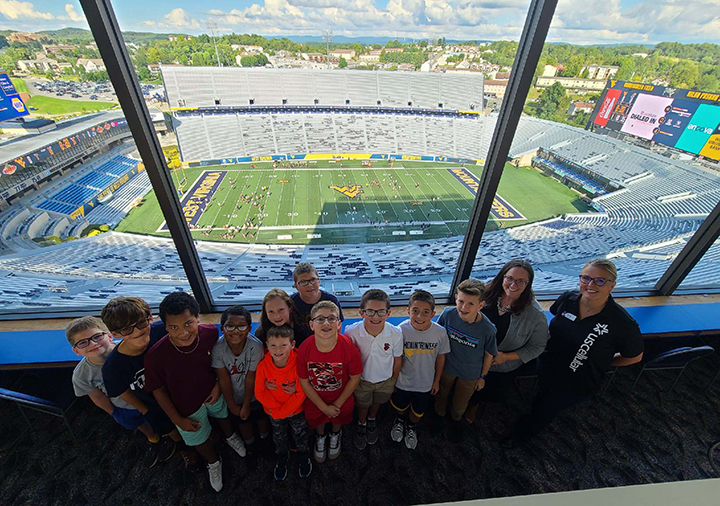Above image by UScellular
Additional images by Marvin Gelhausen
PONDERING THEIR FUTURE CAREERS — Shown above 11 Science Technology Engineering and Math (STEM) fifth through eighth grade Morgantown students were hosted by UScellular and WVU Mountaineer Sports Properties representatives. The students were given a backstage pass for a hands-on experience of how a WVU game day is coordinated, planned, and powered at the WVU Milan Puskar Stadium.
Morgantown STEM/STEAM Students Learn What Powers a WVU Game Day
By Marvin Gelhausen
Managing Editor
MORGANTOWN—Almost a dozen of the best and brightest fifth through eighth grade Monongalia County/Morgantown West Virginia students recently were treated to a behind the scenes look at how a game day at the WVU Stadium is powered. One of the goals of the event was to give the students a look at potential future career opportunities.
The exclusive after school adventure was coordinated between UScellular, coverage provider for the stadium, and various WVU and stadium staff. Brandi McCune, Morgantown area sales manager with UScellular says, “the goal was to give these students an exclusive look into the hustle and bustle behind making game day at WVU a success.” The students learned about the engineering and technology behind what powers a WVU game day, how game day devices and elements stay connected to create a world-class experience for the announcers, referees, athletes, press, attendees, and Mountaineer fans throughout the area who are listening to game highlights. The students also got a look at potential technology jobs right in their hometown that can play off of their STEM/STEAM interests. STEM is an acronym for the fields of science, technology, engineering, and math. Discussion of STEM-related programs has become a presidential priority because too few US college students are pursuing degrees in these fields. STEM has expanded to be STEAM with the addition of arts programs.

HANDS ON EXPERIENCE — Morgantown area 5th through 8th grade stem students pack into the main communications command post of the WVU Stadium to try their hand at placing images, playing music, and showing crowd shots on the stadium scoreboards. The students were guided by WVU Mountaineer Sports Properties staff.
This “backstage pass” experience gave the youths a close-up and hands on look that included visits to the control room, the press box, and radio booth. Students also received an overview of cell antennas built into the stadium architecture, how cell service is connected, maintained and operational. Also, a part of the tour was the distributed antenna system (DAS) located in its own structure outside the stadium. UScellular provides cellular coverage to the stadium through this DAS. Scott Hunter, UScellular network engineer at Morgantown, guided the students on this part of the tour. Many parts of the tour gave these students a look at and insights into parts of the stadium that the average fan never sees. Fans also probably give little thought to how a game is televised, how the scoreboard screen operates, who are the folks behind the scenes making technology work that provides fans with much of their game day experience. These STEM students can now give you insights into all of this, and you might be amazed and surprised at their technology comprehension while only middle school students.
The students learned that there is a lot of pre-planning that goes into preparation for each game day. An attempt is made to draft a game script that is timed down to the minute. Plans are made for what video and music gets played on the scoreboards, what support will be needed for which sports network may be televising the game, when the WVU Band will go out on the field, when there will be crowd photo shots, and much more. “We have to be able to react on the fly,” one control room worker told the students. For example, “if touchdowns are scored quicker than anticipated it requires real time rearranging of the script to cover what is happening on the field.”

READYING FOR A RADIO BROADCAST — Students listen as they learn about the WVU Sports Radio broadcasts that keep fans informed each Mountaineer Football gameday whether the game is at the WVU Stadium or on the road at stadiums across the US.
In the radio booth, the students learned that the broadcast is streamed to a webcam so a worker on the field or down in the crowd can get a comment that will be incorporated and played later. Pre-planning started in June for the first football game in August. The planners contact and establish communication with the West Virginia Air National Guard, the entity that will do flyovers during home games in a C-130 aircraft. Radios are also used to communicate with the vendor who sets off fireworks when the Mountaineers score.
“Our broadcast is one of the most listened to in the nation, we have a great fan base,” one of the radio broadcasters told the students. Prior to covid, the entire radio broadcast team would travel to each away game. During covid, the process was changed with three traveling and two remaining in Morgantown. Technology allows the broadcasters in Morgantown to talk to the broadcasters on site at the game and the listener has no idea that the entire group is not together at one location. Another covid change is that all press meetings are now done using Zoom rather than being in-person.
On game days, at least 70 members of the press arrive at the press box and each needs to connect to wi-fi. Another operational aspect where technology plays a part is ticket validation. As thousands of fans file through the stadium gates, few realize that when their ticket is scanned software connected to a vendor in California almost instantaneously validates that the ticket is genuine and valid. If there are any glitches, the fan is directed to the ticket booth to have any issues resolved.
The IT employees do pre-checks of everything to try and ensure that each component is functioning and ready for gameday usage. IT is always onsite to respond to any issues and ensure each user maintains connectivity. The staff includes two workers plus others that work in engineering. “I do a lot of walking, probably five miles each game day,” noted one of the IT workers. Students were also told that there is no separate backup if the internet goes down. They do have the option of switching from one entrance point to another which can sometimes keep the internet functioning.

TECHNOLOGY GIVES CONNECTIVITY — A member of the WVU Mountaineer Sports Properties IT Staff explains to the STEM students the internet and connectivity needs that sports journalists bring to each WVU game as these professionals fill the press box and look to share game highlights to print, digital, radio and television audiences.
The IT rep explained that outside of game days there is still a lot of work to be done. He said new pieces of equipment arrive and need to be installed, other items have to be ordered and then installed, as well as installing new software. When things break down, they have to research how to fix it and sometimes reinstall the software to bring it back into operation. They have some 330 pieces of equipment they maintain, 290 operate on the Windows platform and 40 to 50 are Mac computers. These IT employees work for the WVU Athletics, so they handle technology for football, basketball, and other WVU sports programs.
The students asked if there have been any game days when technology did not work. They were told of one time when the ticket scanners went down at all gates and lines were backed up for 35 to 40 minutes as the issue was being resolved. Then some 10 to 14 years ago, the scoreboard went down on a Saturday game. It was an issue that could not be immediately resolved. IT had to send the computer that operates the scoreboard out for repair and get it back before the next game which was on the upcoming Thursday. They made it work.
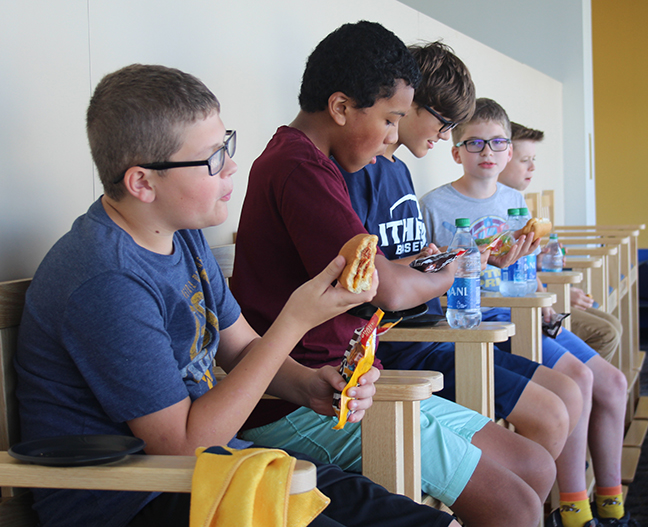
BEST SEATS IN THE STADIUM — Shown above, STEM students enjoy a meal of West Virginia pepperoni rolls, chips, drinks, and other snack items during a stop in the WVU Press box during a recent after school facility tour sponsored by UScellular.
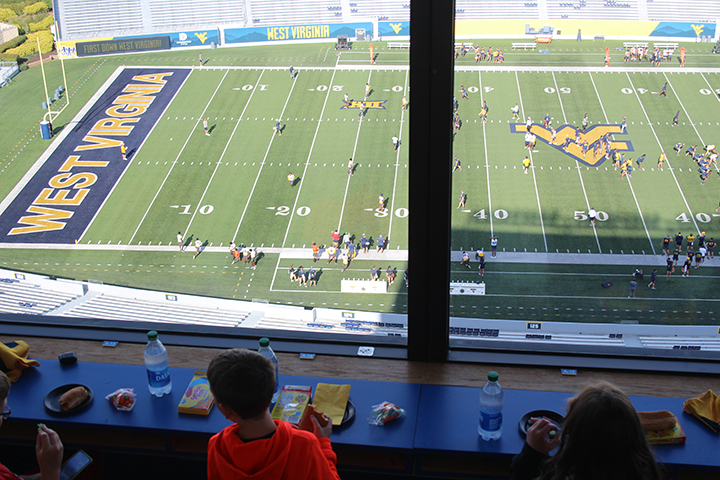
WATCHING A WVU FOOTBALL PRACTICE — During their snack break, STEM students got to experience the view sports journalists get from the press box at the WVU Stadium.
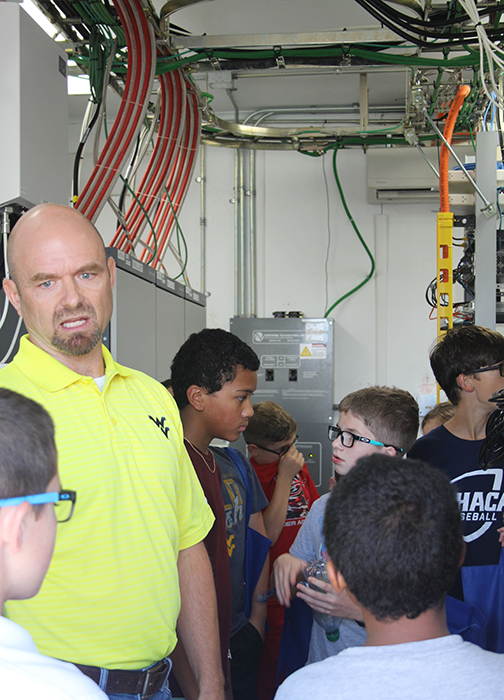
THE CONTROL HUB — UScellular Engineer Scott Hunter explains the distributed antenna system (DAS) main control center for UScellular’s WVU Stadium operations. Located in its own structure outside the stadium, the equipment and specialty wiring allow thousands of cell phone calls and internet connections to maintain seamless connectivity when the WVU Stadium is full of excited football fans and sports journalists covering each game.
Looking out from the press box, it was pointed out that the boxes on top of the stadium support pillars with WVU logos on them are actually wi-fi antennas. Once they walked over to the DAS building, Scott Hunter explained to the students that those antennas on top of the stadium towers do all the work. He explained that the stadium is divided into sections and the antennas have been distributed so they can allow 60,000 cell calls or cell users to be using their devices during a game. He noted that if that many are using devices all at the same time, it can slow down service a bit but the system remains connected and usable.
Melissa Watkins, UScellular PR Counsel, says, “The special tour was organized with our WVU Mountaineers Sports Properties partners as we are a proud sponsor of the Mountaineers and love to bring educational content relating to STEM to our communities. We worked with Sean Merinar, Assistant Director, Athletics Video Productions at WVU and Andrew Caridi, Director of Broadcasting.” She adds, “This is the first STEM tour we have done with WVU, and we look forward to bringing more educational opportunities to Morgantown through our partnership. UScellular recently sponsored a Youth Day with WVU that featured STEM activities and has worked with 4-H and local boys’ and girls’ clubs in the area. The company also gave donations to MARS (Morgantown Area Robotics Program) and the SPARK Science Center in Morgantown as surprises last holiday season.”
Watkins noted that, “UScellular is focused on addressing gaps in STEM education and is committed to connecting more than 200,000 of tomorrow’s innovators each year with the resources they need today to help shape future opportunities. Since 2009, UScellular has donated nearly $22.6 million along with countless experiences and technology items to nonprofit organizations across the country.” For more information about UScellular’s corporate social responsibility initiatives, please go to https://newsroom.uscellular.com/community/
United States Cellular Corporation provides a comprehensive range of wireless products and services, excellent customer support, and a high-quality network to customers with 4.8 million retail connections in 21 states. For those who did not participate in the tour, but who have an interest in careers with UScellular, may be interested to know UScellular offers a wide variety of internships and careers at https://www.uscellular.jobs/. A sample of offerings can be viewed at: https://www.uscellular.jobs/job/ENG001974/2023-Summer-Intern-Automation-and-Data-Engineering.
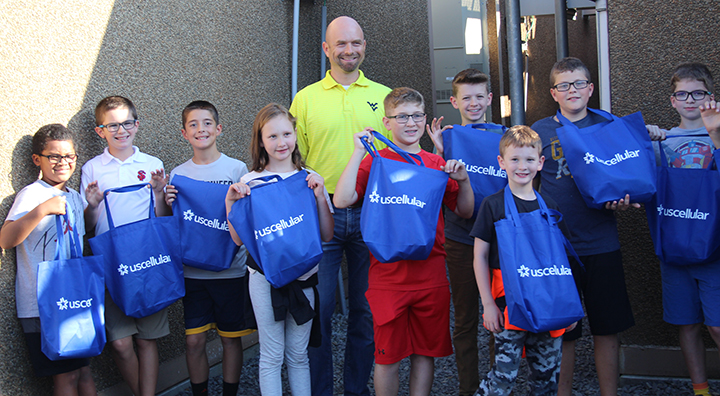
WRAPPING UP THE TOUR — Eleven fifth through eighth grade Morgantown area STEM students display goodie bags from UScellular filled with items to help them remember their recent special after school tour of behind-the-scenes operations at the WVU Mountaineer stadium that power each gameday. UScellular engineer Scott Hunter is shown with the students outside the DAS building which was the final stop on the exclusive backstage facility tour.
Wrapping up the tour, McCune said, “UScellular is proud to support the local youth through sponsorship of this tour, its WVU sponsorship, and the recent sponsorship of WVU Youth Day.” According to Wikipedia, “United States Cellular Corporation is an American mobile network operator. It is a subsidiary of Telephone and Data Systems Inc. The company was formed in 1983 and is headquartered in Chicago, Illinois.”
Participating in the tour from UScellular were Sarah Zerbee, local marketing manager from Cedar Rapids;
Traci Cash, local brand marketing manager, from Knoxville; Becky Kruse, sponsorship marketing manager, from Milwaukee; Scot Hunter, network engineer, from Morgantown; and Brandi McCune, area sales manager, Morgantown. They were assisted by WVU Mountaineer Sports Properties representatives: Terri Young, Kelly Dovey, Evan Hawkins, and Jacob Lough. The students enjoyed West Virginia pepperoni rolls and other snacks before being picked up by their parents. They left with lots of stories to share about their tour experience and a possible career seed or two may have been planted within one or two of the young minds.
Rate this post
Click on a star to rate it!
Average rating 4 / 5. Vote count: 4
No votes so far! Be the first to rate this post.

